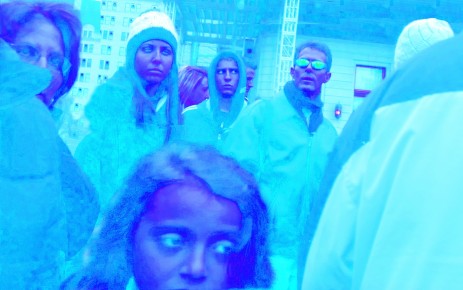 Photo: Adam D. SacksJames Inhofe.
Photo: Adam D. SacksJames Inhofe.
Marc Morano.
Richard Lindzen.
Bjørn Lomborg.
George W. Bush.
Names of shame, ignominy, criminals against humanity, against planet Earth itself. Agents of the lethal delays in our response to escalating, accelerating, catastrophic global warming.
Yet, as deniers of climate change, they’re amateurs compared to us. Us activists, environmentalists, scientists, and certainly Copenhagen politicians.
Even though we’re believers, not skeptics, our denial is far more insidious and subtle. So subtle, in fact, that we’ve managed to convince ourselves that we’re not in denial at all. Quite the opposite. Why, the thought is too absurd even to contemplate.
But it’s true.
We’re deniers every time we say “80 percent by 2050,” or even “80 percent by 2020”; every time we refer to tipping points in the future tense; every time we advocate substituting “clean” energy for “dirty” energy; every time we buy a squiggly light bulb or a hybrid vehicle; every time we advocate for cap-and-trade, or even a carbon tax; every time we countenance the mention of loopy geoengineering schemes; every time we invoke the future of our children and grandchildren and ignore the widespread suffering from global climate disruption today.
Every time we say these things and more, we’re promoting denial of dire climate reality, the reality that’s spinning out of our grasp so fast that we conduct our frenetic climate “solutions” efforts in a kind of stupor, obsessing with parts-per-million statistics, keeping desperately busy to ward off our own utter collapse borne of despair.
The reality we’re denying? We’re denying that we’ve put so much carbon into the atmosphere already that positive feedback loops are well on their way to amplification hell.[1] We’re denying that time lags between carbon emissions and their effects are frighteningly relevant, and that the disastrous effects we’re seeing now are from emissions of 30 years ago. We’re denying that non-linear responses of physical systems cannot be calculated and therefore are perilously ignored. We’re denying that our consumption and waste have far exceeded planetary capacity, possibly irreparably so.[2]
We’re denying reality because we’re not talking about it; we’re invoking fantasies and free lunches instead.[3]
Why do we act like this? Because just like the skeptics, we are inordinately fond of our cushy lives. Because we don’t want to give up our privileged, well-stocked existences any more than the skeptics do (and enter the realms of unthinkable thoughts, to wit, go back to the jungles? the caves? the starving, thirsting millions — or is that billions? — never, never, never, not us). Because in our heart of hearts, we want the skeptics to be right. We are brothers and sisters. And so we join them.
But our denial is much, much worse, because we are the ones presumably advocating for action on global climate disruption. And when we fall short, who’s left to do the job?
Here’s an example, in a note from a friend of mine and fellow climate campaigner:
I was quite disappointed by the Union of Concerned Scientists (UCS) presentation last night. The meeting title was “Roadmap to a Carbon-Free Society” or something like that.
There was no roadmap discussed at the meeting. They showed a bunch of charts and graphs showing how we could get to a 26 percent carbon reduction by 2020 and a 56 percent carbon reduction by 2030 (from a 2005 baseline). All those carbon reductions were based on changes to U.S. and state policy, it wasn’t clear what those proposed policy changes would be, although they seemed to involve some sort of cap and trade and a renewable energy mandate.
They were primarily focused on reducing carbon in electricity generation. They had only 2 to 3 percent savings in carbon in buildings. Their proposed savings in the transportation sector seemed to focus on switching to ethanol (but not from corn).
There was absolutely no call to action.
There was no elaboration of priority.
There were no specifics regarding the changes that would need to be made.
This was a U.S.-only proposal. When asked about global effects, they basically said that was out of scope for their project.
I am looking hard for something I can do that will make a real difference in the lives of my children and their children.
Mark
Here’s another example, from UCS again. I don’t mean to pick on them — they have a lot of co-enablers — but they are real scientists, for goodness sake! Yet they are as ensnared in the silencing trappings of culture as any of us. They’re still on an 80-percent-by-2050 path (below 2005, not 1990, levels), and they still imagine that global warming is simply a consequence of greenhouse-gas emissions (“Global Warming Crossroads: Choosing the Sensible Path to a Clean Energy Economy”). As such, they avoid the lethal implications and challenges of the impossible exponential growth that drives our lives (more on this in my Aug. 23, 2009, post, “The Fallacy of Climate Activism”).
After attending some of their mildly alarming but strangely reassuring presentations, I have spoken with several UCS scientists personally, and with hardly a tickle of prodding they quickly confess how panicked they are. Why don’t they just state it outright, in public? Because, they say (just like so many climate activists, with such a uniform voice one might concoct a conspiracy theory), the public can’t take it.[4] People will shrivel up into their TVs and McBurgers and never come out again. Then we’ll really be in a fix. (But I thought we already were?)
In December 2008, the Stockholm Environment Institute (SEI), another well-meaning house of denial, sponsored a forum aimed primarily at climate activists, oddly entitled “Taking Climate Change Seriously” (I guess they figured we hadn’t done that yet). SEI folks are very nice, very smart people whom I like personally. And they are working sincerely and hard on solutions (which, however politically palatable, nonetheless carry very little weight with the thunderous forces of nature).
A very bright, well-spoken UCS scientist opened the show by revealing that she would speak frankly with us, in a way that she wouldn’t with a general audience because they wouldn’t be able to take it. A cartoon flashes onto the screen, showing the entrance to two different movie theatres. One is showing “An Inconvenient Truth,” which has no customers. The other, “A Convenient Lie,” has drawn a large crowd. The implication, of course, is that the public (whom we chronically assume is dumb) doesn’t want to know. She was pretty open about our dire circumstances, however, with those of us who already knew it (remember, we were there to take climate change seriously).
The irony of all of this is that her presentation itself is the embodiment of the convenient lie: that it’s the public’s fault, despite the fact that scientists and climate activists don’t tell them the truth! How on earth are they supposed to know? No wonder the skeptics hold such tenacious sway.
While An Inconvenient Truth was critically important as a wake-up call, the title of the movie became part of the problem: Climate change isn’t simply “inconvenient.” It’s lethal. Yet now that it’s been branded as “inconvenient,” it’s not so bad, we can live with it — we work around inconveniences, right? We do it all the time. Suppose that just yesterday a CFL burned out and it was dark in the hall and I stubbed my toe looking for my shoes and I had to bike to the hardware store (I don’t own a car) and it was chilly and wet outside and my glasses fogged up. That’s “inconvenience.”
Here’s how the public can come to know the truth about climate: repetition. Learning and comprehension require repetition. Think about repetition being used to learn multiplication tables, or in advertising, or in political campaigns, etc. Certainly dire climate explanations require even more repetition because it is difficult emotionally as well as cognitively. But we haven’t yet even begun to tell that story, we are so spooked by our own reactions and what we think others’ reactions will be.
To reiterate, in order to elicit a response commensurate with the problem, we have to start telling the truth about climate. We have never actually tried it!
If we tell the truth, certainly some people will run away at first. But we keep telling it regardless. Otherwise we engage in palliatives as the world crumbles. There really is no other choice.
—–
Finally, I’d like to say a few words about the recent remarkable 350 day, Oct. 24, 2009, when thousands of coordinated demonstrations across the world stated the climate emergency message loud and clear. An unprecedented and truly impressive organizing effort. I attended the local convocation of several communities meeting in Concord, Mass. We were regaled by activist politicians, a playful tug of war between costumed buckethead deniers and polar bears, post-hippie music, brochures, and photo ops galore.
And generous dollops of denial. I found it all rather depressing. People were enthusiastic about sending our banners to Copenhagen, as if the “leaders” there would care (they would pretend, of course). The clean energy revolution held center stage, as if simply substituting windmills and solar panels now would make a difference to our beyond-tipped-point physics, as if it were all just an energy problem.
But just scratch the surface and it was clear that we were grasping at straws, and the sense of helplessness and hopelessness, bleeding through the forced cheer, was pervasive. Perhaps we must confront and embrace the depths of our despair before we can see clearly. Once we do, however, the remarkable fact is that we can likely do something about climate catastrophe, despite the necessity, for the moment, of bypassing our globally failed political process. Very briefly, local self-sufficiency and sustainability, steady-state no-impact economics, eco-restoration, and rational birth reduction (starting with but clearly not limited to “developed” countries, whose impacts per capita are many multiples of third-world countries).
Sounds difficult or even close to impossible. The question is how badly do we want it. Clearly not badly enough — yet. It will require a dizzyingly quick cultural transformation, but the seeds have been planted and are starting to sprout worldwide. We can turn this disaster into opportunity and hope.
But only if we transcend our denial, and stop lying to the public.
And, especially, stop lying to ourselves.
—
Endnotes:
[1] Strictly speaking, it may be difficult to nail down a feedback loop in action, such as melting ice. At what point can we say “the ice is melting and the resulting darker, warmer waters are more rapidly melting ice resulting in more darker, warmer waters” (amplifying feedback loop), as opposed to “the ice is melting simply because temperatures are warmer due to increasing atmospheric carbon” (no amplifying feedback loop, just garden variety endless global carbon pollution).
Here’s what I suspect is the key: acceleration. Think of moving a microphone towards a speaker, the volume and frequency of the feedback rapidly accelerate. Similarly, the climate phenomena that have arrived decades early, perhaps early by a century or more, may well be the manifestations of feedback loops in action before we know exactly what they are.
[2] I’ve written about this before, in “The Fallacy of Climate Activism,” but I think it bears a lot of repetition. I hope you will write about it too.
[3] Barry Commoner, in his 1971 book The Closing Circle, defined the four laws of ecology succinctly and directly: Everything comes from something (there’s no such thing as a free lunch), everything goes somewhere, everything is connected to everything else, and nature knows best.
[4] For a critically important alternative perspective, see Clive Hamilton and Tim Kasser, “Psychological Adaptation to the Threats and Stresses of a Four-Degree World” [PDF]. “Among the methods to encourage adaptive coping strategies, Crompton and Kasser recommend that that environmental campaigns could: help people express their feelings of fear, sadness and helplessness; gently point out when people are avoiding facing up to the facts of climate science; and, promote problem-focused strategies and mindfulness … Among the methods to encourage a value shift, Crompton and Kasser recommend that environmental campaigns could: avoid appealing primarily to selfish desires and motivations (such as by promoting “Ten ways you can save money by reducing your carbon emissions”); frame messages to connect with intrinsic values like cooperation and non-material benefits; and, deploy programs that activate an awareness of the inherent value of nature and empathy for non-human animals.” (pp. 7-8)



